
Papal Coinage
.pdf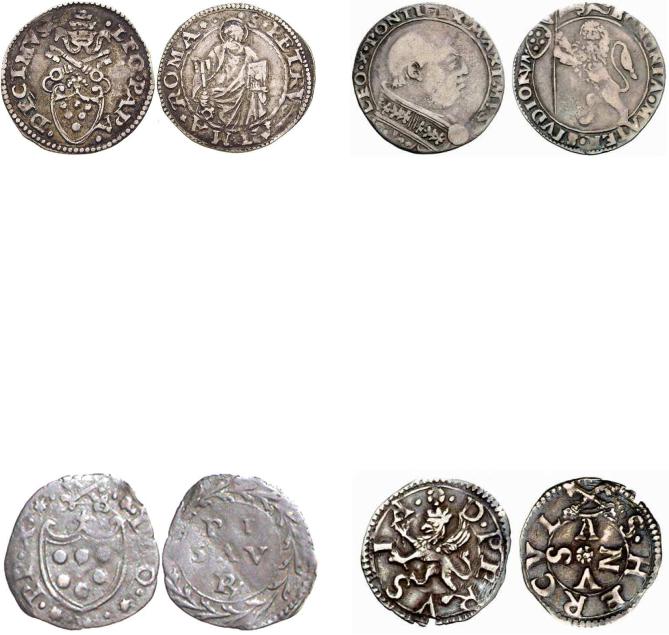
PAPAL COINS
Leo X., 1513-1521.
1/4-Giulio. Rome mint. 0,91 g.
Obv.: LEO PAPA DECIMVS Papal arms surmounted by crossed keys and papa tiara.
Rev.: Nimbate 3/4-bust of St. Peter frontal, lookign slightly to right, holding key and book. S PETRVS ALMA ROMA
Reference: Berman 650; CNI 110-131; Muntoni 35. VF.
Estimation DM 250. Price realized: 360 DEM (approx. 163 U.S. Dollars as of the auction date)
PAPAL COINS
Leo X., 1513-1521.
Cu Quattrino. Pesaro mint.
Obv.: Medici coat of arms surmounted by crossed keys and papal tiara. LEO PP X
Rev.: PI/SAV/Rx in wreath.
Reference: Muntoni 157. Very scarece, F-VF.
Estimate: 75 EUR. Price realized: 105 EUR (approx. 125 U.S. Dollars as of the auction date)
PAPAL COINS
Leo X., 1513-1521.
Mezzo bianco (?) Bologna mint. 28 mm 3,12 g.
Obv.: Bust of pope right. LEO X PONTIFEX MAXIMVS
Rev.: Lion standing left, face frontal, holding banner. BONONIA MATER STVDIORVM Medici arms breaks legend in field left.
Reference: CNI 42. Muntoni 111 var. I. Berman 692. Rare. VF.
Estimate: EUR 300. Price realized: 550 EUR (approx. 816 U.S. Dollars as of the auction date)
PAPAL COINS
Anonymous issue, 16th Century, time of Leo X., 1513-1521.
Soldino. Perugia mint. ca. 1513-1549 21 mm
Obv.: Griffin left. D PERVSIA
Rev.: Crossed keys over S.HERCVL A-N-V-S in cruciform.
Reference: Muntoni 1, Berman 787. Scarce, VF. In CNI this coin is listed under Pope Leo X.
Estimate EUR 100. Price realized: 260 EUR (approx. 326 U.S. Dollars as of the auction date)
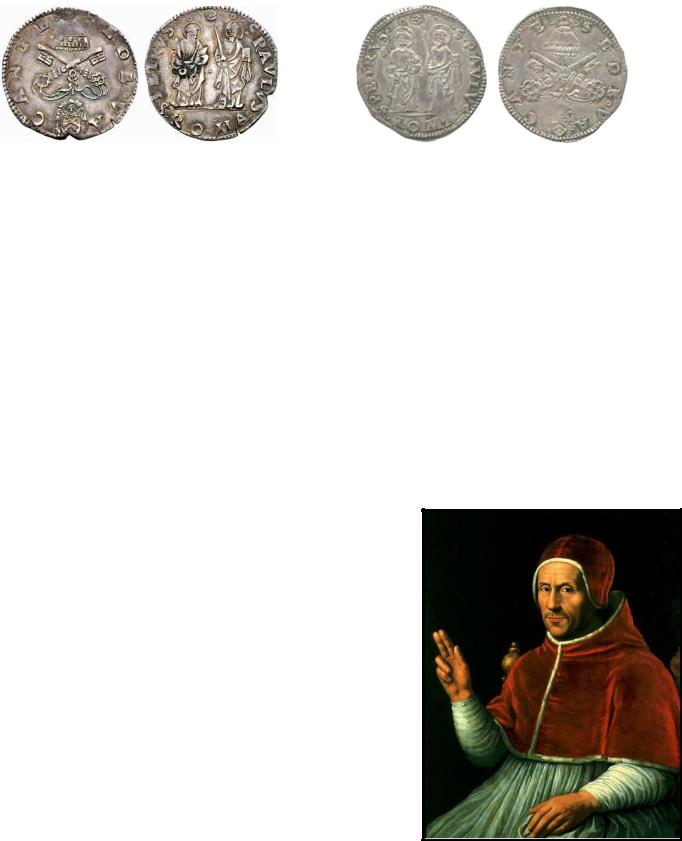
Sede Vacante 1-12-1521 to 9-1-1522
PAPAL COINS
Sede Vacante, 1521-1522.
Giulio. Rome mint. 27 mm 3.68 g.
Obv.: SEDE ° VA - CANTE °. Crossed keys surmounted by papal tiara; coat of arms in exurge.
Rev.: ° S PETRVS°° - °° S P AVLVS ° ROMA in exurge. Nimbate St. Peter with key and book, and nimbate St. Paul with sword and book stand frontal; both lookign slightly to left.
Reference: Berman 795; Muntoni 2. Very rare. XF. Some rim damage.
Estimate CHF 5000. Price realized: 5,300 CHF (approx. 4,518 U.S. Dollars as of the auction date)
PAPAL COINS
Sede Vacante, 1521-1522.
Giulio. Rome mint. 3.73 g.
Obv.: SEDE ° VA - CANTE °. Crossed keys surmounted by papal tiara; coat of arms in exurge.
Rev.: ° S PETRVS°° - °° S P AVLVS ° ROMA in exurge. Nimbate St. Peter with key and book, and nimbate St. Paul with sword and book stand frontal; both lookign slightly to left.
Reference: (CNI 11; M 3; B 795). A delightful well-toned extremely fine piece and very rare.
Estimate: £ 1200. Price realized: 2,300 GBP (approx. 4,368 U.S. Dollars as of the auction date)
Adrian VI - 9 Jan. 1522 to 14 Sept. 1523
Pope Adrian VI (Utrecht, March 2, 1459 – September 14, 1523), born Adriaan Florenszoon Boeyens, son of Floris Boeyens, served as Pope of the Roman Catholic Church from 1522 until his death. He was the last non-Italian pope until John Paul II, 456 years later. He is, together with Marcellus II, one of two modern popes to retain his baptismal name as his regnal name. He is buried in the German national church in Rome, Santa Maria dell'Anima. He has been the only Dutch Pope in the history of the Roman Catholic Church.
He was born under very modest circumstances in the city of Utrecht, which at that time was capital of the bishopric of Utrecht, the Netherlands. Utrecht was at that time part of the Holy Roman Empire. In Germany he is often considered the 7th German pope, as the Holy Roman Empire was largely inhabited by Germans, but especially because of nationalistic purposes during the 19th century. His nationality (not ethnicity, which was undoubtly Dutch) more accurately was that of an 'imperial subject' rather than 'German'. Nevertheless 'German' is often used as the demonym of the Holy Roman Empire, though not always correctly.
He was the last pope to have come from outside Italy until the election of the Polish Pope John Paul II in 1978. Adrian VI was in addition the only pope from the Netherlands as well as the last 'German' pope until the election of Pope Benedict XVI.
Adrian VI was known for having attempted to launch a Catholic Reformation as a defense against the Protestant Reformation. He was, however, ignored by his contemporaries.
Adrian studied under the Brethren of the Common Life, either at Zwolle or Deventer. He was also a student of the Latin school (now Gymnasium Celeanum) in Zwolle.[2] Some texts mention his name as Adrian or Adriaan Florisz, A. Florisz Boeyens, A. Florens or any other combination. 'Florens' or 'Florisz' means 'Floriszoon' – son of Floris. In fact, his father was called Floris and his grandfather Boeyen. Therefore, he is sometimes referred to as Adriaan, son of Floris, son of Boeyen: Adriaan Florisz Boeyens.
At the University of Louvain he pursued philosophy, theology and Canon Law, with a scholarship granted by Margaret, Duchess of Burgundy, becoming a Doctor of Theology in 1491, dean of St. Peter's and vice-chancellor of the university. His lectures were published, as recreated from his students' notes – among those who attended them was the young Erasmus.
In 1507 he was appointed tutor to the seven-year-old Charles, grandson of the Emperor Maximilian I (1493 – 1519), who was to reign as Emperor Charles V (1519 – 58). He was sent to Spain in 1515 on a diplomatic errand. After his arrival at the Imperial court in Toledo, Charles V secured his succession to the see of Tortosa, and on 14 November 1516 commissioned him Inquisitor General of Aragon. The following year, Pope Leo X (1513 – 21) created him a cardinal, naming him Cardinal Priest of the Basilica of Saints John and Paul.
During the minority of Charles V, Adrian was named to serve with Francisco Cardinal Jimenez de Cisneros as co-regent of Spain. After the death of the latter, Adrian was appointed, on 14 March 1518, General of the Reunited Inquisitions of Castile and Aragon, in which capacity he acted until his departure for Rome on 4 August 1522 to assume his pontificate. During this period, Charles V left for the Netherlands in 1520, making the future pope Regent of Spain, in which capacity he had to cope with the revolt of the comuneros.
In the conclave at the death of the Medici Pope Leo X, his cousin, Cardinal Giulio de' Medici was the leading figure. With Spanish and French cardinals in a deadlock, the absent Adrian VI was proposed and on January 9, 1522 he was elected pope by an almost unanimous vote. The Emperor Charles V was delighted upon hearing that his tutor was elected to the papacy but soon realized that Adrian VI was determined to reign impartially. Francis I who feared that Adrian would become a tool of the Emperor, and had uttered threats of a schism, later relented and sent an embassy to present his homage. Fears of a Spanish Avignon based on the strength of his relationship with the Emperor as his tutor and regent proved false. Adrian left for Italy at the earliest possible time and made his solemn entry into Rome on 29 August. Pope Adrian VI was crowned in St. Peter's Basilica on the 31 August, at the age of sixty-three and immediately entered upon the lonely path of the reformer. The Catholic Encyclopedia characterized the task that faced him:
"To extirpate inveterate abuses; to reform a court which thrived on corruption, and detested the very name of reform; to hold in leash young and warlike princes, ready to bound at each other's throats; to stem the rising torrent of revolt in Germany; to save Christendom from the Turks, who from Belgrade now threatened Hungary, and if Rhodes fell would be masters of the Mediterranean-- these were herculean labours for one who was in his sixty-third year, had never seen Italy, and was sure to be despised by the Romans as a 'barbarian'. “
His program was to attack notorious abuses one by one; but in his attempt to improve the system of granting indulgences he was hampered by his cardinals; and reducing the number of matrimonial dispensations was impossible, for the income had been farmed out for years in advance by Leo X.
The Italians saw in him a pedantic foreign professor, blind to the beauty of classical antiquity, penuriously docking the stipends of great artists. Musicians such as Carpentras, the composer and singer from Avignon who was master of the papal chapel under Leo X, left Rome at this time, due to Adrian VI's indifference or outright hostility to the arts. Musical standards at the Vatican declined significantly during his tenure. Famous 'speaking statue' Pasquino (actually a mutilated marble statue of Menelaus holding the body of Patroclus once admired by Cardinal Oliviero Carafa and located in the Piazza di Pasquino near Piazza Navona; another Roman copy of the ancient Greek statue exists at the Loggia della Signoria in Florence) made many remarks on his papacy, growing from funny and witty poems, to downright hurtful accusations. This process, going on from right after his election, arrived at the point where Adrian VI declared he wanted to throw the statue into the Tiber river. The Italian poet Torquato Tasso, however, convinced him not to.
As a peacemaker among Christian princes, whom he hoped to unite in a protective war against the Turks, he was a failure: in August 1523 he was forced openly to ally himself with the Empire, England, Venice, etc., against France; meanwhile in 1522 the Sultan Suleiman I (1520 – 66) had conquered Rhodes.
In dealing with the early stages of the Lutheran (later to be called Protestant) revolt in what is now Germany, Adrian VI did not fully recognize the gravity of the situation. At the diet which opened in December 1522 at Nuremberg he was represented by Francesco Chiericati, whose private instructions contain the frank admission that the whole disorder of the Church had perhaps proceeded from the Roman Curia itself, and that there the reform should begin. However, the former professor and Inquisitor General was stoutly opposed to doctrinal changes, and demanded that Luther be punished for heresy.
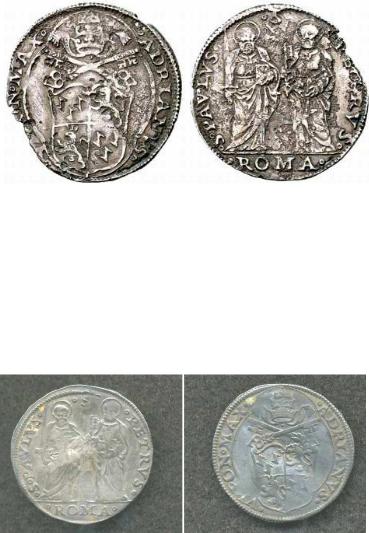
The statement in one of his works that the pope could err, privately or in a minor decree, in matters of faith (haeresim per suam determinationem aut Decretalem assurondo) has attracted attention. Catholics claim that it was just a private opinion, not an ex cathedra pronouncement, therefore it does not conflict with the dogma of papal infallibility, while others claim that the concept of ex cathedra was only invented in the 19th century. Adrian VI died on 14 September 1523, after a pontificate too short to be effective.
Most of Adrian VI's official papers disappeared soon after his death. He published Quaestiones in quartum sententiarum praesertim circa sacramenta (Paris, 1512, 1516, 1518, 1537; Rome, 1522), and Quaestiones quodlibeticae XII. (1st ed., Leuven, 1515).
Italian writer Luigi Malerba used the confusion among the leaders of the Roman Catholic Church, which was created by Adrian's unexpected election, as backdrop for his amusing 1995 novel, Le maschere (The Masks), about the struggle between two Roman cardinals for a well-endowed church office.
PAPAL COINS
Adrian VI, 1522-1523.
Giulio. Rome mint. 30 mm 2,94 g.
Obv.: ADRIANVS VI PON MAX VIII Coat of arms surmounted by crossed keys and papal tiara, in quadrilobe.
Rev.: S PAVLVS S PETRVS Nimbate St. Paul with sword and book, and nimbate St. Peter with key and book, frontal, ROMA in exurge.
Reference: CNI 14. Muntoni 8. Berman 798. Rare. Some corrosion. VF.
Estimate: EUR 200. Price realized: 200 EUR (approx. 297 U.S. Dollars as of the auction date)
PAPAL COINS
Adrian VI, 1522-1523.
Giulio. Rome. mint.
Obv.: ADRIANVS VI PON MAX VIII Coat of arms surmounted by crossed keys and papal tiara, in quadrilobe.
Rev.: S PAVLVS S PETRVS Nimbate St. Paul with sword and book, and nimbate St. Peter with key and book, frontal, ROMA in exurge.
Reference: Berman-798, VF details with a center crease. A very scarce issue for the only Dutch Pope who was in office for only a short time.
Estimate: 300-400 USD. Price realized: 500 USD

Clement VII - 26 Nov. 1523 to 25 Sept.1534
Pope Clement VII (May 26, 1478 – September 25, 1534), born Giulio di Giuliano de' Medici, was a cardinal from 1513 to 1523 and was Pope from 1523 to 1534.
He was born in Florence one month after his father, Giuliano de' Medici, was assassinated in the Pazzi Conspiracy. Although his parents had not had a formal marriage, a canon law loophole allowing for the parents to have been betrothed per sponsalia de presenti meant that Giulio was considered legitimate. He was thus the nephew of Lorenzo the Magnificent, who educated him in his youth.
Giulio was made a Knight of Rhodes and Grand Prior of Capua, and, upon the election of his cousin Giovanni de' Medici to the pontificate as Pope Leo X (1513–21), he soon became a powerful figure in Rome. Upon his cousin's accession to the papacy, Giulio became his principal minister and confidant, especially in the maintenance of the Medici interest at Florence as archbishop of that city. On 23 September 1513, he was made cardinal and he was consecrated on 29 September. He had the credit of being the main director of papal policy during the whole of Leo X's pontificate.
At Leo X's death in 1521, Cardinal Medici was considered especially papabile in the protracted conclave. Although unable to gain the Papacy for himself or his ally Alessandro Farnese (both preferred candidates of Emperor Charles V (1519–58)), he took a leading part in determining the unexpected election of the short-lived Pope Adrian VI (1522–23), with whom he also wielded formidable influence. Following Adrian VI's death on 14 September 1523, Medici finally suc-
ceeded in being elected Pope Clement VII in the next conclave (November 19, 1523).
He brought to the Papal throne a high reputation for political ability, and possessed in fact all the accomplishments of a wily diplomat. However, he was considered worldly and indifferent to what went on around him, including the ongoing Protestant reformation.
At his accession, Clement VII sent the Archbishop of Capua, Nikolaus Cardinal von Schönberg, to the Kings of France, S pain and England, in order to bring the war then raging in Europe to a peace. But his attempt failed.
Francis I of France's conquest of Milan in 1524 prompted the Pope to quit the Imperial-Spanish side and to ally himself with other Italian princes, including the Republic of Venice, and France in the January of 1525. This treaty granted the definitive acquisition of Parma and Piacenza for the Papal States, the rule of Medici over Florence and the free passage of the French troops to Naples. This policy in itself was sound and patriotic, but Clement VII's zeal soon cooled; by his want of foresight and unseasonable economy he laid himself open to an attack from the turbulent Roman barons, which obliged him to invoke the mediation of the Emperor. One month later, however, Francis I was crushed and imprisoned in the Battle of Pavia, and Clement VII veered back to his former engagements with Charles V, signing an alliance with the viceroy of Naples.
But he was to change sides again when Francis I was freed after the Peace of Madrid (January 1526): the Pope entered in the League of Cognac together with France, Venice and Francesco Sforza of Milan. Clement VII issued an invective against Charles V, who in reply defined him a "wolf" instead of a "shepherd", menacing the summoning of a council about the Lutheran question.
The Pope's wavering politics also caused the rise of the Imperial party inside the Curia: Pompeo Cardinal Colonna's soldiers pillaged the Vatican City and gained control of the whole of Rome in his name. The humiliated Pope promised therefore to bring the Papal States to the Imperial side again. But soon after, Colonna left the siege and went to Naples, not keeping his promises and dismissing the Cardinal from his charge. From this point on, Clement VII could do nothing but follow the fate of the French party to end.
Soon he found himself alone in Italy too, as the duke of Ferrara had sided with the Imperial army, permitting to the horde of Landsknechts led by Charles III, Duke of Bourbon, and Georg von Frundsberg, to reach Rome without harm.
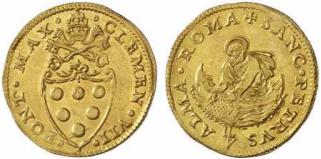
Charles of Bourbon died during the long siege, and his troops, unpaid and left without a guide, felt free to ravage Rome from May 6, 1527. The innumerable series of murders, rapes and vandalism that followed ended forever the splendours of the Renaissance Rome. Clement VII, who had displayed no more resolution in his military than in his political conduct, was shortly afterwards (June 6) obliged to surrender himself together with the castle of Sant'Angelo, where he had taken refuge. He agreed to pay a ransom of 400,000 ducati in exchange for his life; conditions included the cession of Parma, Piacenza, Civitavecchia and Modena to the Holy Roman Empire. (Only the last could be occupied in fact.) At the same time, Venice took advantage of his situation to capture Cervia and Ravenna while Sigismondo Malatesta returned in Rimini.
Clement was kept as a prisoner in Castel Sant'Angelo for six months. After having bought some Imperial officers, he escaped disguised as a peddler, and took shelter in Orvieto, and then in Viterbo. He came back to a depopulated and devastated Rome only in October 1528.
Meanwhile, in Florence, Republican enemies of the Medici took advantage of the chaos to again expel the Pope's family from the city.
In June of the following year the warring parts signed the Peace of Barcelona. The Papal States regained some cities and Charles V agreed to restore the Medici to power in Florence. In 1530, after an eleven-month siege, the Tuscan city capitulated, and Clement VII installed his illegitimate son Alessandro as Duke. Subsequently the Pope followed a policy of subservience to the Emperor, endeavouring on the one hand to induce him to act with severity against the Lutherans in Germany, and on the other to elude his demands for a general council.
One momentous consequence of this dependence on Charles V was the break with the Kingdom of England occasioned by Clement VII's refusal in 1533 to sanction the annulment of Henry VIII of England's (1509–47) marriage to Catherine of Aragon. Clement VII used various stalling tactics and delays. He paid spies to steal Henry VIII's love letters to his fiancée, Anne Boleyn, to prove that they were lovers. However, no evidence could be uncovered and even Clement VII had to grudgingly admit that all impartial evidence from England suggested that Anne Boleyn was strong-willed but morally upright. Clement VII's procrastination on the issue ultimately resulted in the English Parliament passing the Act of Supremacy (1534) that established the independent Church of England.
During his half-year imprisonment in 1527, Clement VII grew a full beard as a sign of mourning for the sack of Rome. This was a violation of Catholic canon law, which required priests to be clean-shaven; however, it had the precedent of the beard which Pope Julius II had worn for nine months in 1511-1512 as a similar sign of mourning for the loss of the Papal city of Bologna.
Unlike Julius II, however, Clement VII kept his beard until his death in 1534. His example in wearing a beard was followed by his successor, Pope Paul III, and indeed by twenty-four popes who followed him, down to Pope Innocent XII, who died in 1700. Clement VII was thus the unintentional originator of a fashion that lasted well over a century.
Towards the end of his life Clement VII once more gave indications of a leaning towards a French alliance, which was prevented by his death in September 1534. He was buried in Santa Maria sopra Minerva.
As for the arts, Pope Clement VII is remembered for having ordered, just a few days before his death, Michelangelo's painting of The Last Judgment in the Sistine Chapel.
PAPAL COINS
Clement VII, 1523-1534.
Doppio fiorino di camera. Rome mint. 6,74g.
Obv.: CLEMEN VII PONT MAX Coat of arms surmounted by crossed keys and papal tiara.
Rev.: +SANC PETRVS ALMA ROMA Nimbate St. Peter fishing with net in boat, facing to left. Trident mark at bottom.
Reference: Berman 829; CNI 46; Muntoni 14; Friedberg 59. XF.
Estimation CHF 3000. Price realized: 3,400 CHF (approx. 2,581 U.S. Dollars as of the auction date)
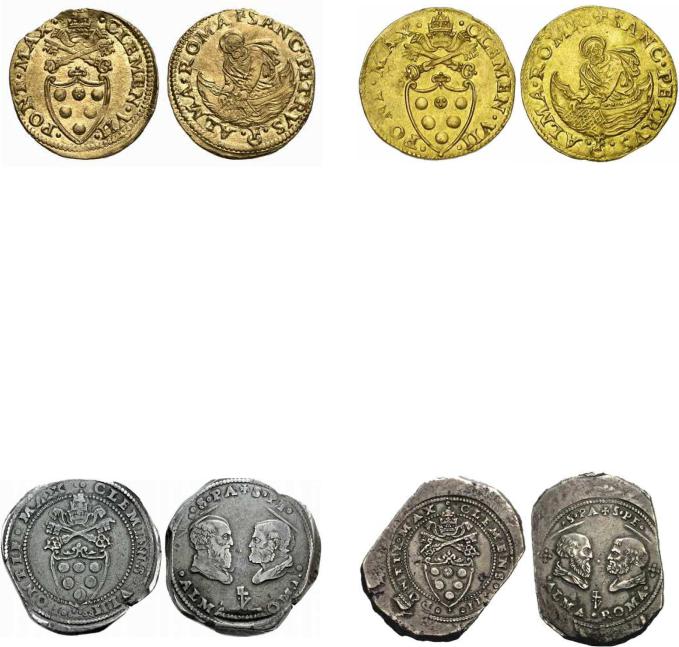
PAPAL COINS
Clement VII, 1523-1534.
Fiorino di camera. Rome mint. 3,41g.
Obv.: CLEMEN VII PONT MAX Coat of arms surmounted by crossed keys and papal tiara.
Rev.: +SANC PETRVS ALMA ROMA Nimbate St. Peter fishing with net in boat, facing to left. F over crescent mark at bottom.
Reference: Fb. 60; Muntoni 16 light var. GOLD. Some rim damage, but still XF example.
Estimate: 500.00 EUR. Price realized: 650 EUR (approx. 780 U.S. Dollars as of the auction date)
PAPAL COINS
Clement VII, 1523-1534.
Silver Ducato. Coined in Saint Castel Angelo during the Sack of Rome. 36 mm 35.50 g.
Obv.: CLEMENS.VIII (!) PONTIF MAX. Coat of arms surmounted by crossed keys and papal tiara; in pearled circle.
Rev.: S PA + S PE - ALMA ROMA Nimbate busts of St. Paul and St. Peter.
Reference: Berman 832; Brause-Mansfeld Tf. 29,1; Dav. 8362; Slg. Gnecchi 4522; Muntoni 21. Extremely rare. Good F. *NOTE THE ERROR in pope’s number.
Estimate CHF 40000. Price realized: 47,000 CHF (approx. 39,170 U.S. Dollars as of the auction date)
PAPAL COINS
Clement VII, 1523-1534.
Fiorino di camera. Rome mint. 3,41g.
Obv.: CLEMEN VII PONT MAX Coat of arms surmounted by crossed keys and papal tiara.
Rev.: +SANC PETRVS ALMA ROMA Nimbate St. Peter fishing with net in boat, facing to left. F over crescent mark at bottom.
Reference: Munt., 16 var; Berman, 830; Fr., 60. 3,38g. Rare. a. EF
Estimate: EUR 1.500. Price realized: 2,800 EUR (approx. 3,700 U.S. Dollars as of the auction date)
PAPAL COINS
Clement VII, 1523-1534.
Silver Ducato. Coined in Saint Castel Angelo during the Sack of Rome. 45 mm 36.81 g.
Obv.: CLEMENS . VII . – . PONTIF . MAX Coat of arms surmounted by crossed keys and papal tiara; in pearled circle.
Rev.: S PA + S PE - ALMA ROMA Nimbate busts of St. Paul and St. Peter.
Reference: CNI 151. Muntoni 21. Serafini IV, 224, 12a. Spaziani Testa 2 var. (R6). Davenport 8326. Berman 832 var. Traina tav. CDII, 3. Martinori, Annali, I, p/ 138, nota 2. Extremely rare. Wonderful condition considering the mintage circumstances.
Estimate: CHF 30000. Price realized: 47,000 CHF (approx. 37,305 U.S. Dollars as of the auction date)
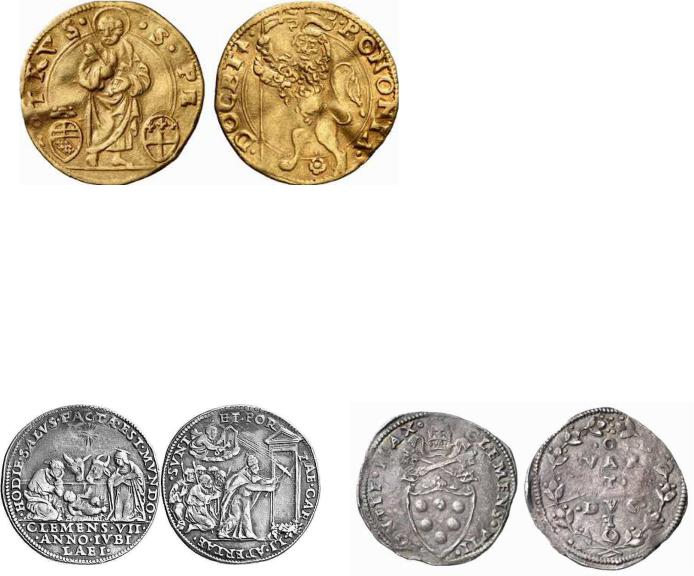
PAPAL COINS
Clement VII, 1523-1534.
AR 1/4-Ducato. Rome mint. Anno Iubilaei [1525]. 9,20 g.
Obv.: The infant Jesus lying the manger between Joseph and Mary, and with a donkey and cow looking on from behind; above, star; in exergue. HODIE SALVS FACTA EST MVNDO around; in exurge: CLEMENS VII/.ANNO.IVBI/LATI.
Rev.: The Pope standing right, opening the Holy Door; behind, five pilgrims; above, St. Peter opening the door of Heaven. SVNT ET PORTAE CAELI APERTAE
Reference: Berman 835. CNI XV, p. 379, 6. Muntoni 26. Very rare. Toned. Has been holed, plugged and repaired, otherwise, very fine.
Ex Ratto, 25 October 1962, 99. As was noted in the Ratto auction catalogue, virtually all known examples of this coin had at one time been mounted and used as devotional medals.
Estimate: CHF 1’500.00. Price realized: 2,900 CHF (approx. 1,929 U.S. Dollars as of the auction date)
PAPAL COINS
Anonymous issue under Clement VII, 1523-1534.
Ducato. Bologna mint. 3,38 g.
Obv.: Nimbate St. Peter stands frontal, looking to left, holding ket and book; flanked by coats of arms of pope and Bologna. S PETRVS
Rev.: Rampant lion left, holding banner. ROsette below.
DOCET BONONIA
Reference: Fb. 341; Muntoni 22 (Band IV, Teil III: Anonyme
Prägungen). GOLD. Somewhat curved, VF.
Estimate: 1000 EUR. Price realized: 1,300 EUR (approx. 1,993 U.S. Dollars as of the auction date)
PAPAL COINS
Clement VII, 1523-1534.
1/4-Ducato. Coined during the siege of Castel Angelo by Imeprial troop (1527). 8,21 g.
Obv.: CLEMENS VII PONTI MAX Coat of arms surmounted by crossed keys and papal tiara.
Rev.: Q/VART/DVC over retrograde F above crescent, all in laurel wreath.
Reference: Brause-Mansfeld - (like Tf. 29, 6); Maillet - (like Suppl. Tf. 64, 3); Muntoni 36. Very rare. Slight weakness in strike. VF.
Estimate: 3.000 EUR. Price realized: 6,300 EUR (approx. 8,007 U.S. Dollars as of the auction date)
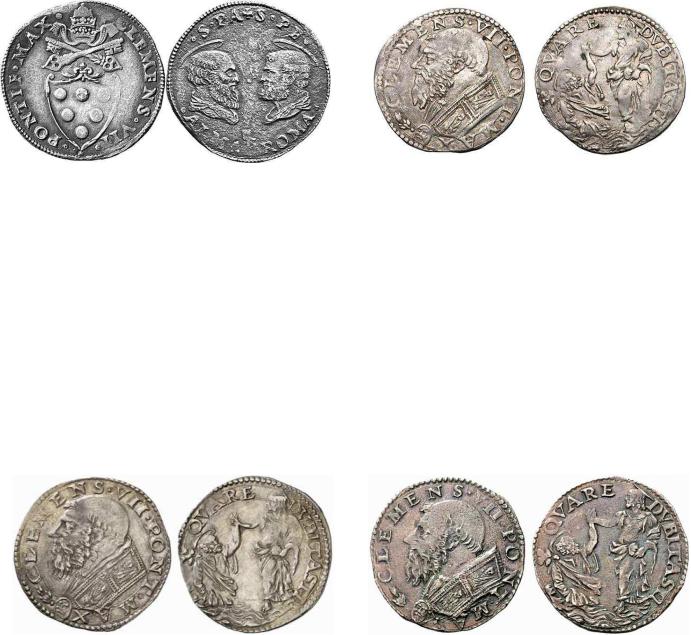
PAPAL COINS |
PAPAL COINS |
Clement VII, 1523-1534. |
Clement VII, 1523-1534. |
Double Giulio. Rome mint 7,07 g. |
Double Carlino. (1-1/2 Giulio) Rome mint. 5,53 g. |
Obv.: CLEMENS VII PONTIF MAX Coat of arms surmounted by crossed k |
Obv.: CLEMENS VII PONTIF MAX Bust of pope left. |
eys and papal tiara. |
|
|
Rev.: QVARE DUBITASTI Jesus pulling St. Peter from water. |
Rev.: S PA + ST PE ALMA ROMA Nimbate busts of Sts. Paul and Peter |
|
facing each other; below, mintmark. |
Reference: Berman 841. Well struck. About extremely fine. Dies cut by |
|
Cellini. |
Reference: Berman 840. CNI XV, p. 387, 71. Muntoni 40. Toned. Reverse sur- |
|
faces corroded, otherwise, good very fine. |
Estimate: US$2400. Price realized: 2,000 USD |
Estimate: CHF 1’250.00. Price realized: 1,000 CHF (approx. 665 U.S. Dollars |
|
as of the auction date) |
|
PAPAL COINS
Clement VII, 1523-1534.
Double Carlino. (1-1/2 Giulio) Rome mint. 5,31 g.
Obv.: CLEMENS VII PONTIF MAX Bust of pope left.
Rev.: QVARE DUBITASTI Jesus pulling St. Peter from water.
Reference: Berman 841; CNI 60; Muntoni 43. Very rare. VF. Dies cut by
Cellini.
Estimation CHF 10000. Price realized: 14,000 CHF (approx. 10,627 U.S. Dollars as of the auction date)
PAPAL COINS
Clement VII, 1523-1534.
Double Carlino. (1-1/2 Giulio) Rome mint. 30 mm 5,09 g.
Obv.: CLEMENS VII PONTIF MAX Bust of pope left.
Rev.: QVARE DUBITASTI Jesus pulling St. Peter from water.
Reference: CNI 60. Muntoni 43. Berman 841. Dies cut by Cellini. Minimal porosity. VF.
Estimate: EUR 800. Price realized: 1,300 EUR (approx. 1,929 U.S. Dollars as of the auction date)
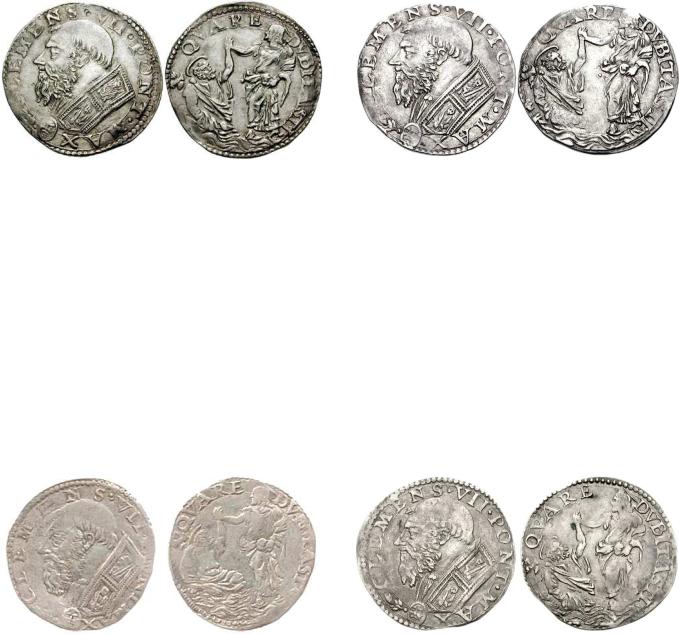
PAPAL COINS
Clement VII, 1523-1534.
Double Carlino. (1-1/2 Giulio) Rome mint. 5,36 g.
Obv.: CLEMENS VII PONTIF MAX Bust of pope left.
Rev.: QVARE DUBITASTI Jesus pulling St. Peter from water.
Reference: CNI XV pg. 386, 60; Muntoni I pg. 149, 43; Berman 841. Near EF. Marvelous Renaissance portrait with dies engraved by Benvenuto Cellini. Rome mint, mm: crossed hands.
Estimate $1500. Price realized: 3,000 USD.
PAPAL COINS
Clement VII, 1523-1534.
Double Carlino. (1-1/2 Giulio) Rome mint. 5,09 g.
Obv.: CLEMENS VII PONTIF MAX Bust of pope left.
Rev.: QVARE DUBITASTI Jesus pulling St. Peter from water.
Referencec: CNI XV 60; Muntoni 43; Berman 841. Good VF.
Estimate: $4000. Price realized: 4,600 USD.
PAPAL COINS
Clement VII, 1523-1534.
Double Carlino. (1-1/2 Giulio) Rome mint.
Obv.: CLEMENS VII PONTIF MAX Bust of pope left.
Rev.: QVARE DUBITASTI Jesus pulling St. Peter from water.
Reference: (Ber.841; CNI.386.61; Munt.43), possibly slightly clipped, about very fine, rare and interesting. Dies by Benvenuto Cellini.
Estimate £ 1,500-1,750.
PAPAL COINS
Clement VII, 1523-1534.
Double Carlino. Rome mint. 5,33 g.
Obv.: CLEMENS VII PONTIF MAX Bust of pope left.
Rev.: QVARE DUBITASTI Jesus pulling St. Peter from water.
Reference: CNI XV 60; Muntoni 43; Berman 841. Good VF, lightly toned. Exquisite die workmanship. Dies engraved by Benvenuto Cellini.
Estimate: 2000 USD. Price realized: 2,400 USD
